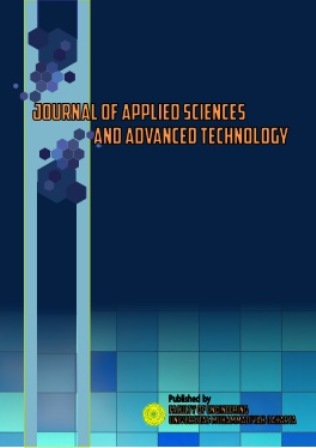Characterization of Pigmented Bacillus Species Isolated from Aquatic Environment
DOI:
https://doi.org/10.24853/jasat.4.2.51-62Keywords:
Characterization Bacillus Isolated PigmentAbstract
The genus of Bacillus includes several group of genetically and phenotypically different. Some species of spore-forming bacteria are pigmented, although the role of these pigments has not been fully elucidated. This study aimed to isolate a new species of Bacillus species and characterize both pigmented and pigment-producing bacteria product. For this purpose, samples were used water to isolate spore-forming bacteria and verify the presence of pigmentation. All bacteria found pegmatite were characterized at the species level and one of those selected for further studies. The physiological and biochemical analysis carried out revealed that: I) the product is carotenoid pigment, II) its synthesis takes place in stationary phase of growth. These features have allowed for us to assume that the carotenoid is produced under conditions of cellular stress and probably involved in cellular adaptation to some environmental conditions are not optimal for the cell.Downloads
References
Manzo, N., DiLuccia, B., Isticato, R., D’Apuzzo, E., De Felice, M., Ricca, E. 2013. Pigmentation and Sporulation are alternative cell fates in Bacillus pumilus SF214. PLoS ONE 8(4): e62093. https://doi.org/10.1371/journal.pone.0062093
Nicholson, W.L., Fajardo-Cavazos, P., Rebril, R., Slieman, T.A., Riesenman, P.J., Law, F., Xue, Y. 2002. Bacterial endospores and their significance in stress resistance. Antonie Van Leeuwenhoek. 81 (1-4): 27-32.
Sella, Sandra R.B.R., Vandenberghe, Luciana P.S., Soccol, C.R. 2014. Life cycle and spore resistance of spore –forming bacillus atrophaeus. Microbiological Research. 169 (12): 931-939
Tocheva, E.I., Matson, W.G., Morris, D.M., Moussavi, F., Leadbetter, J.R., Jensen, G.J. 2011. Peptidoglycan Remodeling and Conversion of an Inner Membrane into an Outer Membrane During Sporulation. National Institute of Health. 146 (5): 799-812
Checinska, A., Burbank, M., Paszczynski, A.J. 2012. Protection of Bacillus pumilus Spores by Catalases. Applied and Environmental Microbiology. 78 (18): 6413– 6422
Siefert, J.L., Larios-Sanz, M., Nakamura, L.K., Ralph A. Slepecky, R.A., Paul, J.H., Moore, E.R.B., Fox, G.E., Peter Jurtshuk, Jr. 2000. Phylogeny of Marine Bacillus Isolates from the Gulf of Mexico. Current Microbiology. 41: 84-88
Setlow, P. 2014. Germination of Spores of Bacillus Species: what we know and do not know. Journal of Bacteriology. 196(7): 1297–1305.
Banerjee, D., Chatterjee, S., Banerjee, U.C., Guha, A.K., Ray, L. 2011. Green Pigment from Bacillus cereus M¬¬¬1¬¬16 (MTCC5521): Production Parameters and Antibacterial Activity. Appl. Biochem. Biotechnol. 164: 767-779
Barnett, T.A., Hageman, J. 2011. Characterization of a brown pigment from Bacillus subtilis cultures. Canadian Journal of Microbiology . 29 (3): 309-315
Khaneja, R., Perez-Fons, L., Fakhry, S., Baccigalupi, L., Steiger, S, To, E., Sandmann, G., Dong, T.C., Ricca, E., Fraser, P.D., Cutting, S.M. 2010. Carotenoids found in Bacillus. Journal of Applied Microbiology. 108: 1889-1902
Fakhry, S.S, Sorrentini, I., Ricca, E., De Felice, M., Baccigalupi, L. 2008. Characterization of Spore Forming Bacilli Isolated From the Human Gastrointestinal Tract. J. Appl. Microbiol . 105(6):2178-86
Fakhry, S.S., Hasana, M.A., Hashim, S.T., Jebur, Z.A., Abdulhameed, F.F. 2017. Stress Responses in Pigmented Bacillus Pumilus SF214. Jurnal Teknologi (Sciences & Engineering). 79 (5): 197–201.
Barbosa, Tm., Serra, Cr., LaRagione, RM., Woodward, MJ., Henriques, AO. 2005. Screening for Bacillus isolates in the Broiler Gastrointestinal Tract. Applied Environmental Microbiology. &1 (2): 968- 978
Cuting , S.M., Vavder-Horn, P.B. 1999. Genetic analysis in Molecular Biological Methods for Bacillus ed. Harwood, C.R. and Cutting, S.M.PP,-27 74. Chichester, England: John Wiley& Sons Ltd.
Green, D., Wakelen,P., Page, A., Barnes, A., Baccigalupi, L., Ricca,E and Cutting, S. 1999. Characterization of two Bacillus probiotics species .Appl Environ Microbiol. 65. 4288-4291.
Bachvarov, DR., Ivanov, IG. 1983. Large Scale Purification of Plasmid DNA. Preparative Biochemistry. 13(2): 161-166
Sastry, KP., Kumar, RR., Kumar, AN., Sneha, G., Elizabeth, M. 2012. Morpho-chemical Description and Antimicrobial activity of Different Ocimum species. Journal of plant Development. 19: 53-64
Mendenhall, M.K., Ford, S.L., Emerson, C.L., Wells, R.A., Gines, L.G., Eriks, I.S. 2000. Detection and differentiation of Mycobacterium avium and Mycobacterium genavense by polymerase chain reaction and restriction enzyme digestion analysis. J Vet Diagn Invest 12:57–60
Casjens, S., Huang, WM. 1982. Initiation of sequential packaging of bacteriophage P22 DNA. Journal of Molecular Biology.157 (2): 287-298.
Nucleic acid cleanup In Nucleic Acid Sample Preparation for Downstream Analyses. Principles and Methods in GE Healthcare life science Hand book. Chapter 8 pp. 105-110 available on line https://cdn.gelifesciences.com/dmm3bwsv3/AssetStream.aspx?mediaformatid=10061&destinationid=10016&assetid=14455
Dubanau, DA. 1982. Genetic transformation in Bacillus subtilis. In: The molecular biology of the Bacilli, DA. Dubnau, ed., Academic Press, New York, 1: 148–175
Nakano,M. M., Dailly, Y. P., Zubber, P., Clark, and D. P. (1997) Characterization of anaerobic fermentative growth of Bacillus subtilis: identification of fermentation end products and genes required for growth. J Bacteriol. 179 (21):6749-55.
Reichelt, JL., Baumann, P. 1974. Effect of Sodium Chloride on Growth of Heterotrophic Marine Bacteria.Arch Microbiol. 97(4):329-45.
Sun, B., Zhang, XH., Tang, X., Wang, S., Zhong, Y., Chen, J., Austin, B. 2007. A Single Residue Change in Vibrio harveyHemolysinResultsin the Loss of Phospholipase and hemolytic Activities and Pathogenicity for Turbot (Scophthalmusmaximus). J Bacteriol. Mar; 189 (6):2575-9. Epub 12.
Downloads
Published
Issue
Section
License
COPYRIGHT POLICY
The author(s) of an article published in the Journal of Applied Sciences and Advanced Technology (JASAT) retains ownership of the intellectual property rights in work (s).
PUBLISHING RIGHTS
The author(s) of an article published in the Journal of Applied Sciences and Advanced Technology (JASAT) have unrestricted publication rights. The authors give the Journal of Applied Sciences and Advanced Technology (JASAT) the right to publish the article and designate the Faculty of Engineering Universitas Muhammadiyah Jakarta Publishing as the original publisher of the article.
LICENSING POLICY
JASAT is an open-access journal that follows the Creative Commons Non-Commercial 4.0 International License (CC BY-NC 4.0), which states that:

Under this license, the reusers must give appropriate credit, provide a link to the license, and indicate if changes were made. Users may do so in any reasonable manner, but not in any way that suggests the licensor endorses users or their use.
Please take the time to read the whole license agreement (https://creativecommons.org/licenses/by-nc/4.0/). As long as reusers follow the license conditions, the owner cannot withdraw these freedoms. The following components are included under this license:
 Attribution: Users must provide appropriate attribution, including a link to the license, and indicate whether or not they made any modifications. Users are free to do so reasonably, but not in a manner that indicates the licensee approves of their usage.
Attribution: Users must provide appropriate attribution, including a link to the license, and indicate whether or not they made any modifications. Users are free to do so reasonably, but not in a manner that indicates the licensee approves of their usage.
 NonCommercial: Users may not use the material for commercial purposes.
NonCommercial: Users may not use the material for commercial purposes.












_2.png)


1.png)

2.png)
